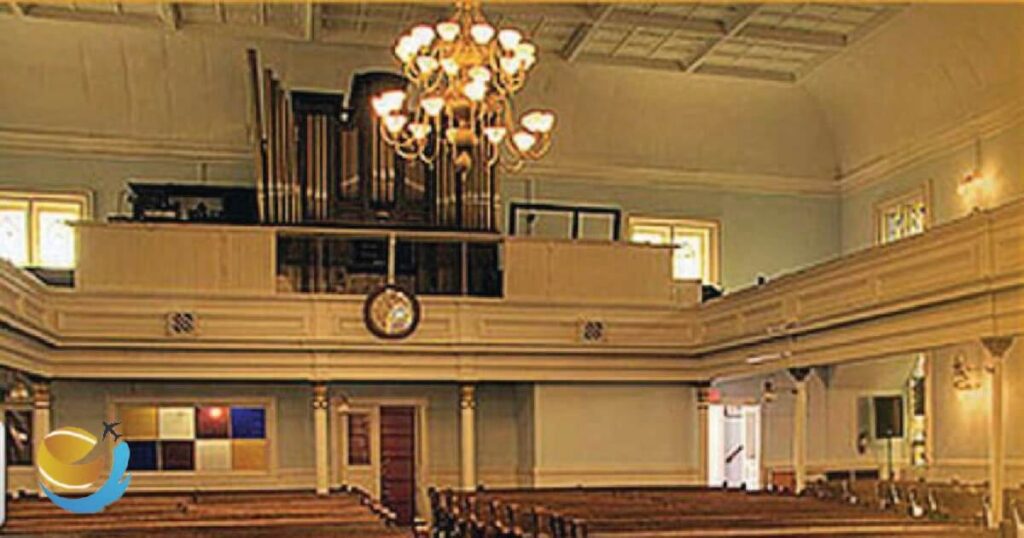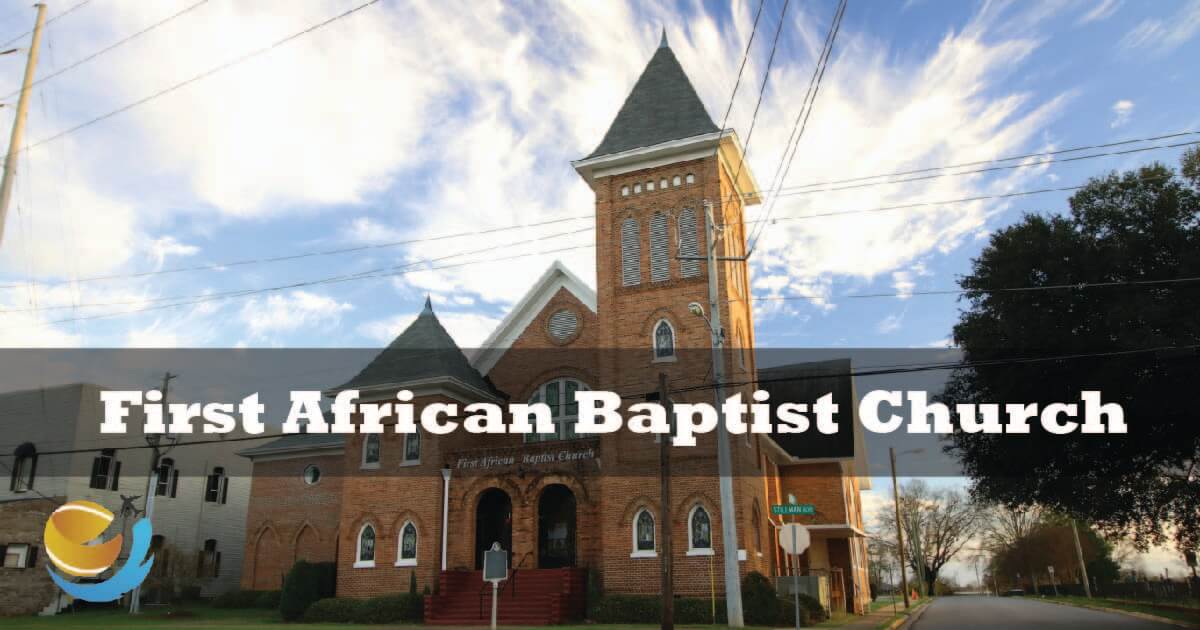Introduction:
Many Visitors want to know about the First African Baptist Church. So in this article, we will completely guide you about the First African Baptist Church. So be ready and uncover the best things about the First African Baptist Church.
Nestled in the historic heart of Savannah, Georgia, stands a testament to resilience, faith, and the enduring spirit of a community: the First African Baptist Church. As one of the oldest African American congregations in the United States, its storied history intertwines with the struggles and triumphs of African Americans throughout the nation’s past.
From its humble beginnings in the late 18th century to its role as a beacon of hope during the darkest days of slavery and segregation, the First African Baptist Church has stood as a pillar of strength and inspiration for generations.
In this article, we embark on a journey through time and space to explore the rich tapestry of narratives woven into the fabric of this historic institution. From its founding amidst the challenges of colonial America to its enduring legacy as a center of worship, community, and activism, we delve into the depths of the First African Baptist Church’s significance.
Through its architectural splendor, cultural contributions, and spiritual resonance, we uncover the profound impact this sacred space continues to have on both its local congregation and the broader landscape of American history.
Join us as we uncover the layers of history, heritage, and hope that define the First African Baptist Church, inviting readers to discover the power of faith, unity, and perseverance in the face of adversity.
First African Baptist Church: Complete Guide
1: Historical Background
Founding of the church in Savannah, Georgia
The origins of the First African Baptist Church are steeped in the complexities of early American history and the enduring struggle for freedom and equality. Founded in Savannah, Georgia, during the late 18th century, the church emerged within the crucible of slavery and oppression, yet it would come to embody the resilience and faith of generations of African Americans.
Early years and growth of the congregation
Established by a small group of enslaved individuals seeking solace and spiritual connection, the church initially met clandestinely, navigating the perilous terrain of slave codes and prohibitions against organized gatherings. Despite these challenges, the congregation persisted, finding strength in their shared faith and commitment to community.

Role of the church during times of slavery and segregation
As the church grew in size and influence, it became a focal point for African American life in Savannah and beyond. From its early years as a refuge for the enslaved seeking liberation to its pivotal role as a center of activism and resistance during the civil rights movement, the First African Baptist Church has remained steadfast in its dedication to social justice and equality.
Notable leaders and members of the church
Throughout its history, the church has been led by visionary pastors and impassioned leaders who have guided its mission with unwavering conviction. Their efforts have not only shaped the destiny of the congregation but have also left an indelible mark on the broader landscape of American religious and social history.
Today, the First African Baptist Church stands as a living testament to the enduring power of faith, community, and the human spirit. Its historical significance resonates far beyond the borders of Savannah, serving as a symbol of hope and inspiration for all who seek to honor the legacy of those who came before us.
2: Cultural and Spiritual Legacy
The cultural and spiritual legacy of the First African Baptist Church is woven into the very fabric of African American history and identity. From its earliest days to the present, the church has served as more than a place of worship it has been a sanctuary of resilience, creativity, and cultural expression.
Preservation of African Spiritual Traditions:
At its inception, the church provided a space for enslaved Africans to preserve and practice their cultural and spiritual traditions in the face of oppression.
Elements of African spirituality and religious practices were interwoven with Christian doctrine, creating a unique syncretic tradition that continues to influence African American religious expression today.
Musical Innovation and Tradition:
One of the most enduring contributions of the First African Baptist Church to American culture is its influence on music. The church played a pivotal role in the development of African American religious music, including spirituals, gospel, and hymns.
These musical forms not only served as expressions of faith but also became powerful tools of resistance and resilience, offering solace and inspiration to generations of worshippers.

Promotion of Social Justice and Civil Rights:
Throughout its history, the First African Baptist Church has been a beacon of hope and activism in the struggle for civil rights and equality.
From its involvement in the abolitionist movement to its leadership in the fight against segregation and discrimination, the church has consistently advocated for social justice and human dignity. Its legacy of courage and perseverance continues to inspire movements for justice and equality around the world.
Community Building and Empowerment:
Beyond its spiritual significance, the First African Baptist Church has served as a center of community building and empowerment. Through education, outreach, and social programs, the church has worked to uplift and support its congregation and the surrounding community, embodying the principles of love, compassion, and solidarity.
As we reflect on the cultural and spiritual legacy of the First African Baptist Church, we are reminded of the enduring power of faith, resilience, and collective action in the face of adversity. Its impact reaches far beyond the walls of its sanctuary, leaving an indelible mark on the hearts and minds of all who encounter its story.
3: Architectural and Artistic Features
The First African Baptist Church stands as a testament to both the spiritual devotion and the architectural ingenuity of its founders and builders. Its structure and artistic elements reflect not only the aesthetic preferences of its time but also the cultural and historical context of African American communities in the South.
Architectural Style:
The church’s architectural style is a blend of various influences, ranging from Georgian and Federal styles to elements of African vernacular architecture. Its simple yet elegant design features a symmetrical facade, sturdy brick construction, and a gabled roof, evoking a sense of stability and permanence.
Stained Glass Windows:
One of the most striking artistic features of the First African Baptist Church is its stained glass windows. These windows, adorned with vibrant colors and intricate designs, depict scenes from biblical narratives and African American history, serving as both a source of inspiration and a testament to the church’s rich cultural heritage.
Interior Decor:
Inside the church, visitors are greeted by a sanctuary adorned with ornate woodwork, decorative plaster moldings, and handcrafted furnishings. The pulpit, altar, and pews are crafted with care and attention to detail, reflecting the craftsmanship and dedication of the artisans who contributed to the church’s construction and embellishment.
Mural and Mosaic Art:
In addition to its stained glass windows, the First African Baptist Church is adorned with mural and mosaic art that celebrates the achievements and contributions of African Americans throughout history.
These artworks, created by local artists and craftsmen, depict scenes of struggle, triumph, and resilience, serving as visual reminders of the church’s commitment to social justice and equality.
Preservation Efforts:
Over the years, the First African Baptist Church has undergone various restoration and preservation efforts to ensure that its architectural and artistic legacy endures for future generations.
These efforts, supported by the congregation and the wider community, have helped to maintain the church’s structural integrity and aesthetic beauty, allowing it to continue to inspire and uplift all who enter its doors.
As we marvel at the architectural and artistic features of the First African Baptist Church, we are reminded of the enduring power of creativity, craftsmanship, and cultural expression in shaping our built environment and enriching our lives.

4: Visitor Experience
Visiting the First African Baptist Church is not merely a tour of a historic site; it’s an immersive journey through centuries of African American history, culture, and spirituality. From the moment visitors step through its doors, they are greeted with warmth, reverence, and a profound sense of connection to the past.
Guided Tours:
Visitors to the First African Baptist Church have the opportunity to embark on guided tours led by knowledgeable docents who share the church’s rich history and significance.
These tours offer insights into the church’s founding, its role in the abolitionist movement, and its contributions to African American culture and religious life.
Educational Exhibits:
Throughout the church, visitors can explore educational exhibits that highlight key moments and figures in African American history.
From displays showcasing artifacts from the Underground Railroad to exhibits celebrating the achievements of African American leaders and activists, these educational resources provide context and depth to the visitor experience.
Sacred Spaces:
The sanctuary of the First African Baptist Church offers visitors a chance to experience the power and beauty of African American religious expression firsthand.
From the soaring ceilings adorned with intricate woodwork to the soft glow of stained glass windows casting colorful patterns of light, a sanctuary is a place of reverence and reflection.
Interactive Programs:
In addition to guided tours and exhibits, the First African Baptist Church offers a variety of interactive programs and events for visitors of all ages.
From storytelling sessions and music performances to hands-on workshops and discussions, these programs engage visitors in meaningful ways and invite them to become active participants in the church’s ongoing legacy.
Community Engagement:
Beyond its role as a historic site, the First African Baptist Church is a vibrant center of community engagement and outreach.
Visitors have the opportunity to learn about the church’s ongoing social justice initiatives, volunteer opportunities, and partnerships with local organizations working to address issues of inequality and injustice.
Whether they come to learn about history, find inspiration in the church’s spiritual legacy, or connect with like-minded individuals committed to social change, visitors to the First African Baptist Church are sure to leave with a deeper understanding of the past and a renewed sense of hope for the future.
Conclusion Of First African Baptist Church:
The First African Baptist Church is a symbol of resilience and cultural significance, inviting visitors to explore African American history and spirituality. From its origins in the late 18th century to its role in social change, the church’s story inspires hope.
As we honor the church’s legacy, let’s remember its impact and strive for justice and equality. By preserving its history and lessons, we can inspire future generations in its message of resilience and faith.
Related Articles:
Best West Coast Florida Beaches: 9 Best Beaches
Romantic Getaways In New Mexico: 13 Top Getaways

